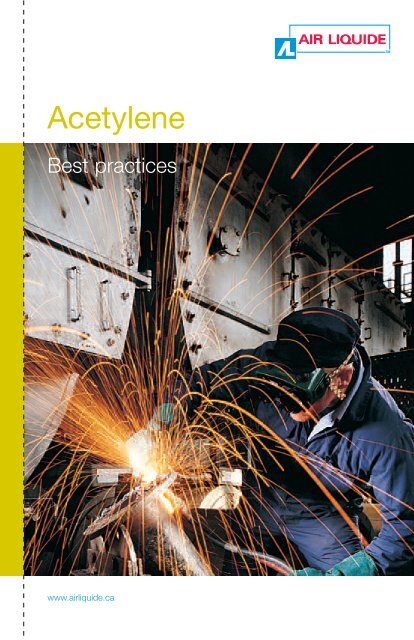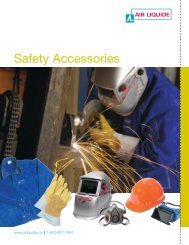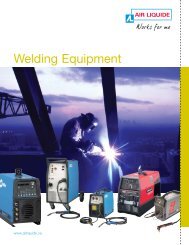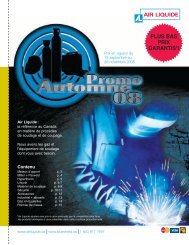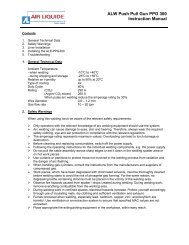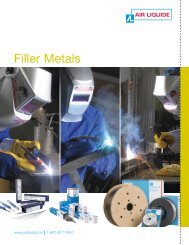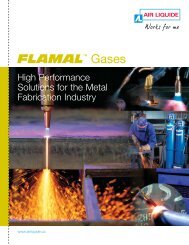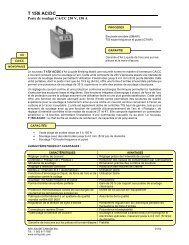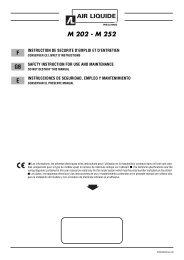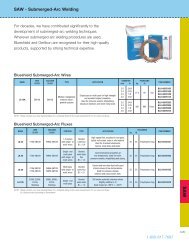Acetylene best practices - BLUESHIELD
Acetylene best practices - BLUESHIELD
Acetylene best practices - BLUESHIELD
Create successful ePaper yourself
Turn your PDF publications into a flip-book with our unique Google optimized e-Paper software.
<strong>Acetylene</strong><br />
Best <strong>practices</strong><br />
www.airliquide.ca
Used mainly in welding, brazing, cutting and<br />
heating, acetylene is the most versatile and<br />
<strong>best</strong> performing fuel gas, overall.<br />
<strong>Acetylene</strong> is a flammable gas that burns in the presence of air or other oxidizers.<br />
When mixed in certain proportions with air or oxygen it can generate an explosive<br />
atmosphere.<br />
Did you know?<br />
<strong>Acetylene</strong> (C 2<br />
H 2<br />
) is not an air gas but is a synthesized gas, produced mainly by the<br />
reaction of calcium carbide with water or as by-products of the petrochemical industry.<br />
In the 19 th century, it was burned in acetylene lamps for lighting houses and mine<br />
tunnels. A gaseous hydrocarbon, it is colourless, with a distinctive garlic odour, unstable,<br />
highly flammable, and produces a very hot flame (more than 3000°C or 5400°F) in the<br />
presence of oxygen.<br />
Other applications of acetylene:<br />
• Laboratories and analysis: used as the fuel gas in atomic absorption analyzers.<br />
• Glass industry: used in automatic lubrication of glass bottle molds.<br />
<strong>Acetylene</strong> is chemically unstable and can decompose<br />
and release a large amount of energy, even in the<br />
absence of air or oxygen, if the cylinder is heated, struck<br />
or dropped.<br />
Close respect of these guidelines could prevent<br />
many serious accidents.<br />
300 g of porous material<br />
contains 1.3 kg of solvent<br />
and 1 kg of acetylene<br />
The following recommendations apply to the use of<br />
acetylene cylinders. The list is not to be considered<br />
complete, and other global recommendations concerning<br />
the risks involved in using gas cylinders in general may<br />
also be applied:<br />
• Cylinder handling<br />
• Cylinder storage<br />
• Cylinder transport<br />
2
Best <strong>practices</strong><br />
on the jobsite<br />
Your workshop or jobsite<br />
should be …<br />
• Clean, orderly and well ventilated<br />
• Secured against fire risks:<br />
- Do not work next to combustible products or<br />
materials<br />
- Locate fire extinguishers before starting any work<br />
Ventilate the work area<br />
If you smell acetylene,<br />
• NEVER use an open flame to check for leaks.<br />
• Use a soap and water solution, or a commercial<br />
leak detector solution that is compatible with oxygen<br />
and acetylene, to check all equipment connections<br />
before starting work.<br />
• NEVER use a leaking cylinder installation.<br />
• If the cylinder leaks:<br />
- Close cylinder valve<br />
- Tag as “leaking”<br />
- Remove cylinder to an outdoor location and post<br />
“no smoking” sign<br />
- Call your gas supplier to collect the cylinder<br />
Test for leaks with<br />
leak detector solution<br />
Never use a<br />
leaking cylinder<br />
3
Best <strong>practices</strong><br />
by the operator<br />
Only trained and experienced<br />
operators should use acetylene<br />
cylinders<br />
They must know and understand:<br />
• Material Safety Data Sheets (MSDS)<br />
• Proper equipment installation and operating<br />
procedures<br />
• Specific hazards associated with the use of<br />
oxy-acetylene equipment<br />
• Actions to take in the case of an accident<br />
Operators must wear appropriate<br />
work apparel and corresponding<br />
personal safety accessories:<br />
• Gloves<br />
• Safety glasses or goggles with correct shade of lens<br />
• Protective clothing<br />
• Safety shoes<br />
Wear your personal safety<br />
protection<br />
Safety<br />
gloves<br />
Safety glasses<br />
or goggles<br />
Protective<br />
clothing<br />
Safety<br />
shoes<br />
4
Best <strong>practices</strong><br />
for equipment<br />
Your gas equipment must be:<br />
• Identified as compatible with acetylene<br />
• In conformance with Canadian standards<br />
(UL, CRN, CSA, etc.)<br />
• Checked regularly and repaired or replaced when<br />
necessary (in the case of damage or expiry date).<br />
It is recommended to install a<br />
flashback arrestor with built-in<br />
check valve in both the oxygen<br />
and the acetylene hose lines<br />
• These safety devices should be tested frequently for<br />
leakage at the check valve and replaced after any<br />
violent flashback.<br />
Use of these devices should not prevent you<br />
! from following normal safety procedures.<br />
Make sure there is no leak at<br />
regulator connections<br />
• High pressure connection between the regulator and<br />
the cylinder valve outlet.<br />
• Low pressure connection between the regulator and<br />
the welding hose.<br />
To locate a leak and to verify the leak tightness of an<br />
equipment installation, use a suitable commercial leak<br />
detector solution that is compatible with oxygen and<br />
acetylene.<br />
NEVER use an open flame to check for leaks.<br />
We recommend the use of a hand-screwed connection<br />
with O-ring seal to avoid leaks at regulator outlet<br />
connections.<br />
Always use specialized<br />
ACETYLENE equipment<br />
Use Grade R or Grade T hose<br />
that conforms to RMA<br />
standard IP-7<br />
Use flashback arrestors with<br />
built-in check valves<br />
Carefully check the<br />
connection between the<br />
regulator and the cylinder<br />
valve outlet<br />
5
Best <strong>practices</strong> when<br />
operating equipment<br />
Before use<br />
• Cylinders must be well secured in the vertical position.<br />
Never use a cylinder in<br />
the horizontal position.<br />
• DO NOT “crack” acetylene cylinder valves to blow dust<br />
from the valve outlet. It could cause a fire.<br />
• Before opening the cylinder valve, completely release<br />
the regulator pressure adjusting mechanism to “close”<br />
the regulator valve (turn counter-clockwise).<br />
• Closely follow the manufacturer’s set-up and operating<br />
procedures. In particular:<br />
Wipe cylinder connections<br />
with a clean, lint-free cloth.<br />
- Before lighting the torch, purge each gas hose<br />
separately, one at a time, for a few seconds to expel<br />
any dangerous gas mixture. After purging, close<br />
each torch valve.<br />
- Set the proper gas pressures for the tip size being<br />
used (see the oxy-fuel pocket guide).<br />
During use<br />
• Use a proper flint lighter to light the acetylene flame.<br />
NEVER use a match or cigarette to light your torch.<br />
Open cylinder valves SLOWLY<br />
and stand with the valve<br />
outlet pointing away from you.<br />
Withdrawal rate from a cylinder<br />
should be limited to 1/7 of its<br />
nominal capacity per hour<br />
to avoid solvent extraction.<br />
Manifold cylinders together<br />
where higher flowrates<br />
are required.<br />
• Always use the equipment at the recommended<br />
operating parameters.<br />
• NEVER bring a lighted torch near a gas cylinder.<br />
After use<br />
• Close both cylinder valves and release the regulator<br />
pressure adjusting mechanisms to the “closed”<br />
position.<br />
• Drain (depressurize) each hose by opening each torch<br />
valve individually.<br />
6
Best <strong>practices</strong> for storage<br />
and transportation<br />
1. Do not store or transport gas cylinders in a<br />
non-ventilated trunk or space.<br />
2. When transporting flammable products, always respect<br />
no smoking recommendations and have a fire<br />
extinguisher available for use.<br />
3. Do not allow gas cylinders to remain in a non-ventilated<br />
space since any increase in temperature and/or minor<br />
leak can increase the risk of fire, explosion or asphyxia.<br />
4. Always close cylinder valves during transport.<br />
Due to their nature, acetylene cylinders are never<br />
completely empty. Ensure that valve protection caps<br />
are in place and that regulators and other equipment<br />
are disconnected from the cylinder during transport.<br />
5. Always ensure that gas cylinders are secured, preferably<br />
in the vertical position. A cylinder that is not properly<br />
secured can become a dangerous projectile in the case<br />
of an accident or sudden stop.<br />
6. Take a route that is most direct – no intermediate stops.<br />
If possible, avoid routes with heavy traffic.<br />
7. When the destination is reached, immediately remove<br />
the cylinder from the vehicle.<br />
8. Depending on the nature and quantity of product, its<br />
transportation may be subject to the Transport of<br />
Dangerous Goods regulation in terms of:<br />
• Shipping documentation<br />
• Display of Dangerous Goods Safety Marks<br />
(i.e. Placards)<br />
• Circulation on roads designated for<br />
dangerous goods<br />
• Training on the regulation and the<br />
products transported<br />
7
Safety measures in case of incident<br />
with an acetylene cylinder<br />
In the presence of ignition or abnormal overheating of an acetylene<br />
cylinder, considering that it may explode at any time,<br />
the following measures must be taken:<br />
• Move away from the affected cylinder.<br />
• Never try to move the cylinder.<br />
• Evacuate the premises immediately.<br />
• Set up a safety perimeter.<br />
• If necessary, ventilate the room if this can be done without endangering the<br />
operator(s), since acetylene leaks can result in an explosive atmosphere.<br />
• Call the fire department. Remind the fire fighters of the risks incurred in the<br />
event of decomposition of the gas.<br />
8
<strong>Acetylene</strong> is a standard fuel gas used in conjunction<br />
with oxygen for welding and cutting steel, and for<br />
allied processes for the heating, forming<br />
and treating of metals.<br />
Air-acetylene flames are also used for soldering and other plumbing<br />
applications where the very high temperature of the<br />
oxy-acetylene flame is not required.<br />
ITEM NUMBER<br />
SIZE<br />
VOLUME 1<br />
CGA<br />
m 3 scf CONNECTION<br />
GAS-ACE2COP 2 0.28 10.10 200<br />
GAS-ACE8COP / GAS-ACE8TCOP* 8 1.10 39.67 520<br />
GAS-ACE8MINITOP 8 1.10 39.67 023<br />
GAS-ACE14* 14 2.08 75.01 410<br />
GAS-ACE23 / GAS-ACE23ALTOP 23 3.60 2 129.83 410 / 023<br />
GAS-ACE69 / GAS-ACE69ALTOP 69 10.30 2 371.46 410 / 023<br />
1<br />
m 3 @ 15ºC; scf @ 70ºF / 2<br />
Typical volume; actual volume may vary<br />
* with tulip cap<br />
9
DISTRIBUTED BY:<br />
www.airliquide.ca<br />
1-800-817-7697<br />
1140-262E (06-07) REL.<br />
Note: This brochure is intended for general information purposes only and is not intended as a representation or warranty<br />
of any kind, or as a statement of any terms or conditions of sale. The information herein is believed to be correct, but is not<br />
warranted for correctness or completeness, or for applicability to any particular customer or situation. The terms and<br />
conditions of any sales transactions that may occur between Air Liquide and any customer shall be set forth in the<br />
agreement signed by the parties.


